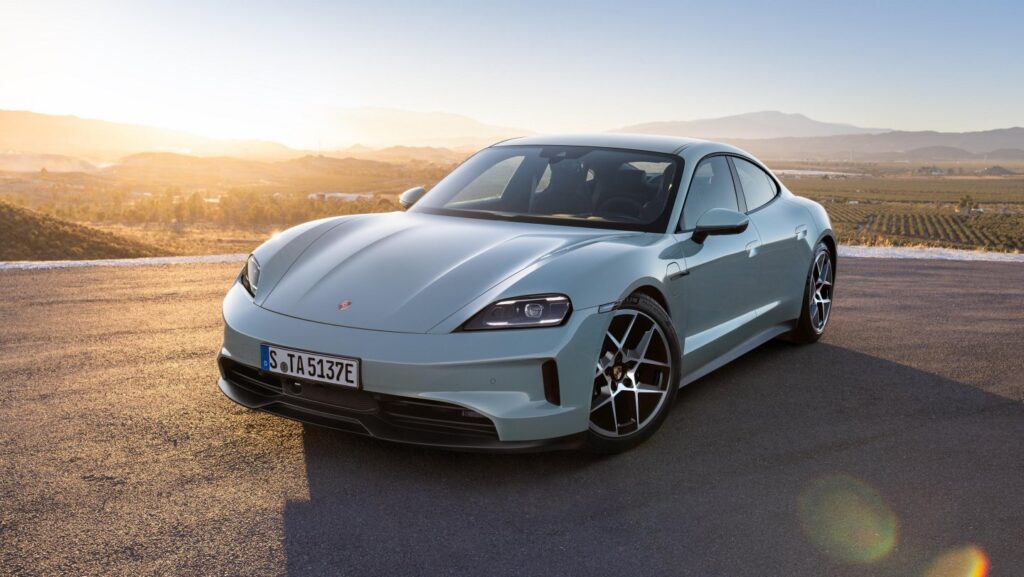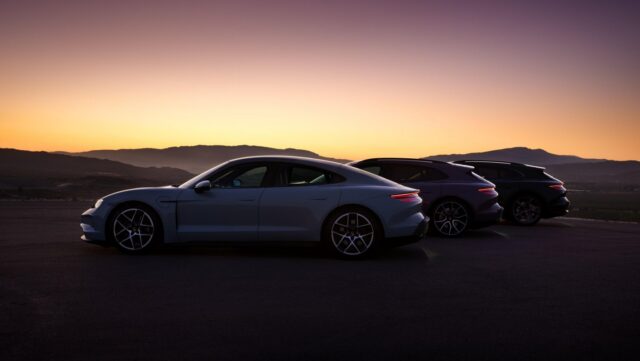Porsche has given the Taycan a particularly extensive update. The new versions have more power, more range, accelerate quicker and charge faster with greater stability.

All three body variants will feature the numerous modifications from the date of launch – the Taycan sports sedan, the versatile Taycan Cross Turismo, which is available with an off-road package, and the sporting-yet-practical Taycan Sport Turismo. In each case, four powertrain options are available, with rear- and all-wheel drive variants. The revised versions will arrive at Porsche Centres from the spring of 2024.

“We ushered in the new era of e-mobility with the Taycan at the end of 2019. It immediately proved to be a game changer and innovative pioneer in the e-vehicle segment,” says head of the model line, Kevin Giek. “We are now continuing this success story with the extensively updated Taycan. The model line has reached new heights in terms of performance, with exceptional driving dynamics and driving pleasure. At the same time, we were able to significantly improve efficiency, range, day-to-day usability and comfort.”
All updated models accelerate much faster than their predecessors. Two examples from both ends of the portfolio: as sports sedans, the Taycan and Taycan Turbo S reach the 100 km/h mark from a standstill in just 4.8 (Taycan: Electric power consumption* combined (WLTP) 20.0 – 16.7 kWh/100 km, CO₂ emissions* combined (WLTP) 0 g/km, Electric range* combined (WLTP) 503 – 678 km, Electric range* in town (WLTP) 569 – 821 km) and 2.4 seconds (Taycan Turbo S: Electric power consumption* combined (WLTP) 20.5 – 17.9 kWh/100 km, CO₂ emissions* combined (WLTP) 0 g/km, Electric range* combined (WLTP) 558 – 630 km, Electric range* in town (WLTP) 612 – 691 km) respectively. This makes them 0.6 and 0.4 seconds faster than their predecessors.With the new push-to-pass function in the Sport Chrono package, a boost of up to 70 kW, depending on the model, can be called upon for 10 seconds at the touch of a button. The increased acceleration rates are generally the result of higher system output. For example, the base Taycan delivers 60 kW more than before. In the Taycan Turbo S, it’s an additional 140 kW with Launch Control. This increases the system output of the top model to 700 kW/952 PS.

Depending on the body variant and engine, the WLTP range has increased to up to 678 km, an increase of 175 km or 35 per cent. The updated Taycan not only requires fewer charging stops on long trips than its predecessor, but it also recharges faster: at 800-volt DC charging stations, for example, it can be charged at up to 320 kW. That’s 50 kW more than before. The fast-charging window of the new performance battery has been significantly expanded. This means that charging capacities of more than 300 kW can be sustained for up to five minutes, and very high charging capacities can be achieved more quickly, even at low temperatures.

Depending on an individual’s driving style, among other variables, this can halve the time required to go from a 10 to an 80 per cent charge compared to the predecessor car. In the first-generation Taycan, the charging time from 10 to 80 per cent SOC at 15 degrees Celsius is 37 minutes. Under the same conditions, the updated Taycan takes just 18 minutes despite its larger battery capacity. The Performance Battery Plus now has a gross capacity of 105 kWh, increased from 93 kWh.
All updated Taycan models come with adaptive air suspension as standard. The new Porsche Active Ride suspension can be ordered as an option for the all-wheel drive versions. This system offers an unprecedented bandwidth between driving comfort and driving dynamics.


Extensive efficiency measures
The simultaneous improvement of performance and efficiency is down to a number of factors: an advanced powertrain with a new rear-axle motor with up to 80 kW more power than its predecessor on all models, a modified pulse inverter with optimised software, more powerful batteries, revised thermal management, a next-generation heat pump and a modified recuperation and all-wheel-drive strategy.
The maximum recuperation capacity during deceleration from high speeds has increased by more than 30 per cent from 290 to up to 400 kW. All variants now come as standard with aerodynamically optimised wheels and reduced-rolling-resistance tyres. New 21-inch wheels and tyres were specially developed for this purpose.
Although the models weigh up to 15 kilograms less2, the standard equipment is even more extensive than before. Ambient lighting, ParkAssist with reversing camera, electrically folding exterior mirrors with mirror surround lighting, heated front seats, Porsche Intelligent Range Manager (PIRM), heat pump with a new cooling system, smartphone tray for wireless charging, electric charging ports on the driver and front passenger sides, Drive Mode switch and Power Steering Plus are all now standard features.

The Taycan base models are now also equipped with adaptive air suspension and aluminium door sill protectors as standard. In addition to the upgraded equipment, the improved product specification includes a battery with increased capacity but with a reduced weight.
Even more attractive design
With new front- and rear-end styling with new headlights and tail lights, the experts at Style Porsche have further honed the clean, purist design of the Taycan. The new front wings and the flatter headlights give even greater emphasis to the width of the Taycan.
The instrument cluster, central display and optional passenger display feature an optimised user interface with additional functions. The mode switch on the steering wheel now comes as standard.
Read the full art. on ”newsroom.porsche.com”
Read also:
– The new Taycan impresses with a real-world range of up to 587 kilometres – ”newsroom.porsche.com”









